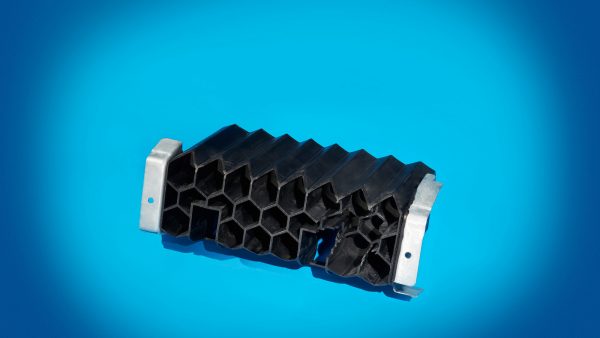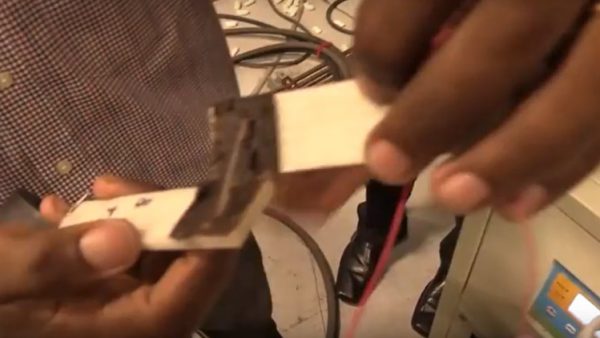Automakers and their suppliers are exercising a variety of methods to help achieve sustainable automotive design to reduce environmental impacts and improve product lifecycle efficiencies.
- Lightweighting to boost fuel economy and reduce greenhouse gas emissions
- Process technology improvements that lower cycle times and reduce energy usage
- Reducing manufacturing waste to impact both the environment and the embodied energy of wasted material
- Computational design methods that optimize product shape to reduce material usage
Advanced plastics and polymer composites can address key automotive sustainability objectives in a variety of ways, including by serving as the lightweight materials of choice for replacing metals; offsetting the additional weight of advanced components such as electric batteries and sensors; offering vehicle longevity and performance benefits through mixed material assemblies; enabling the greater use of nondestructive, software-based modeling and testing to support safe and reliable vehicle operation; and delivering more design flexibility needed to enhance durability, end-of-life vehicle recyclability, and circularity. Specific vehicle design elements and requirements that will be impacted include:
Lightweighting
Design Impacts
Several components including batteries, sensors, electronics, motors, and wiring harnesses are expected to increase the average weight of future vehicles by hundreds of pounds. On average, the components required for Level 4 and 5 autonomy may add 300-400 pounds to vehicles.40 Automakers will require high strength-to-weight materials to offset added weight increases and improve vehicle travel ranges and efficiencies.
Automakers are unlikely to rely on single material solutions to offset the added weight of batteries and autonomous safety systems. Instead, automakers incrementally replace or introduce new materials and components as a low-cost, low-risk approach to reduce vehicle weight
Opportunities for Advanced Plastics and Polymer Composites

Fiber-reinforced polymers (including glass and carbon fiber composite and intermediate materials) can enable complex aerodynamic shapes while improving automotive safety, fuel economy, and performance.
Thin-walled composites and honeycomb materials could help reduce vehicle weight and increase interior cabin space for passenger comfort.41
Advanced plastics and polymer composites reduce automotive weight by an average of 500 pounds.42 Using carbon fiber reinforced polymer composites for mixed-material designs could reduce the weight of some automotive components by 50-75%.43
Transparent polymers for window and glazing systems can provide up to 40% weight reduction compared to glass systems, while also providing additional design freedom.44
Collaborative Activities
High-Performance Materials
| Near (2020–2022)Mid (2023–2025)Long (2026–2030) | |
|---|---|
| Continue sponsorship of critical R&D demonstration programs for polymer composites-intensive automotive designs | Near |
| Demonstrate carbon fiber composite-intensive structures for battery electric vehicle chassis | Near, Mid |
| Increase education and advocacy efforts to communicate automotive lightweighting benefits (e.g., environmental, vehicle range, safety); increase public awareness on the safety, performance, and lightweighting attributes of advanced plastics and polymer composites | Near, Mid |
| Demonstrate the performance benefits of advanced structural adhesives including low specific gravity adhesive systems for lightweight mixed-material assemblies | Near, Mid |
| Develop integrated analysis techniques, test methods, and data to accelerate design of automotive plastics and polymer composites | Mid |
| Pursue innovative methods to optimize performance of plastics and polymer composites and procedures for replacing heavier parts | Mid |
| Coordinate with OEMs to define automotive specifications and materials properties; establish and maintain a database to support materials selection and design efforts | Mid, Long |
| Demonstrate plastics and polymer composite intensive body in white (BIW) concepts that meet requirements for high-volume vehicle builds | Mid, Long |
Mixed Material Design
| Near (2020–2022)Mid (2023–2025)Long (2026–2030) | |
|---|---|
| Conduct a demonstration project for automotive plastics or resin systems with high dimensional stability | Near |
| Identify key automotive subsystem(s) with the greatest opportunities to replace structural components with new high-performance polymer composites (e.g., B-pillar structural components) | Near |
| Conduct a demonstration project for plastics-intensive automotive interiors with focus on personalization and maximum cabin space | Mid |
Multimaterial Joining
Design Impacts

Satisfying automotive lightweight goals via mixed-material design approaches requires consistent and reliable joining techniques to bond or bolt together dissimilar automotive components.
To meet end-of-life recyclability goals, automakers will manufacture vehicles that are designed for easy and economic disassembly for life-extending refurbishment as well as recovery and reuse at the end of their usable life. Consolidating plastic parts and using recyclable polymer grades will help automakers achieve end-of-life recyclability goals.
Sensors, radar, LIDAR, cameras, and other electronics will add complexity to general assembly and testing of future automotive designs. Replaceable or removable components could improve the maintenance-friendliness, repairability, and recalibration of automotive sensors and safety system.
Opportunities for Advanced Plastics and Polymer Composites
Thermoplastic-based reversible bonding techniques can permit the rapid assembly, disassembly, and repair of automotive components for meeting end-of-life recyclability goals.
Materials innovations such as novel curing systems can permit the economic recovery of fibers from thermoset-based composites into remanufactured automotive components, thereby reducing landfill waste.
Form-fitting advanced polymers can be molded into complex shapes to fully encase automotive sensors and safety systems and can reduce assembly steps and cost compared to other materials.45
Materials like resin-transfer-molded carbon non-crimp fabrics can increase part consolidation, resulting in significantly fewer parts and less production floor space compare with conventional metal-based designs.46
Collaborative Activities
Joining Technologies
| Near (2020–2022)Mid (2023–2025)Long (2026–2030) | |
|---|---|
| Continue sponsorship of critical R&D demonstration programs for multimaterial joining processes | Near |
| Identify industry-wide R&D demonstration opportunities to advance novel thermoplastic-based reversible bonding techniques to permit rapid assembly, disassembly, and repair | Near |
| Determine infrastructure requirements for industry-wide automotive repair and replacement of in-service automotive plastics and polymer composites | Near |
| Sponsor pre-competitive efforts to demonstrate the effectiveness of structural adhesives for multimaterial joining, disassembly, and repair | Near, Mid |
| Demonstrate effective joining techniques for metal-composite hybrid structures | Near, Mid |
| Coordinate an industry-wide design competition to create maintenance- and repair-friendly components for encapsulating sensor, LIDAR, and other machine vision components | Mid |
Design for Refurbishment and End-of-Life Recovery
| Near (2020–2022)Mid (2023–2025)Long (2026–2030) | |
|---|---|
| *Demonstrate the performance benefits of structural adhesive joining techniques or plastics-based fasteners as a means for ease of maintenance, repair, and disassembly | Near, Mid |
| Identify an automotive subsystem that would benefit from re-design for ease of disassembly; sponsor a design pilot to demonstrate the concept through existing technology demonstration programs | Near |
| Establish automotive industry standards and test methods (including tools and approaches for disassembly) for new interior composites applications | Mid |
| Coordinate an industry-wide initiative to encourage end-of-life disassembly procedures for improved recovery of automotive components (e.g., electronic components) | Mid, Long |
Sensor Encapsulation
| Near (2020–2022)Mid (2023–2025)Long (2026–2030) | |
|---|---|
| Define application specifications to inform material suppliers of specific sensor placement/location for optimum multimodal sensor detection | Near |
| Identify areas of vehicles with the greatest opportunities for consolidation of electrical parts using high-performance plastics and polymer composites | Mid |
Nondestructive Evaluation
Design Impacts

Manufacturers use NDE technologies to evaluate part performance without causing damage to parts, reduce costly experimental testing, and validate predictive materials and manufacturing models. As average vehicle usage rates increase and lifespans decrease, NDE techniques will become more useful for rapidly assessing the structural health and integrity of automotive components to ensure safety and reliable vehicle operation.
Opportunities for Advanced Plastics and Polymer Composites
NDE technologies are used for measuring resin concentration, fiber concentration, fiber loading, fiber size, fiber orientation, fatigue, disbands (interfaces), and delaminations (inter-layers) of fiber-reinforced polymer composites (FRPCs).
Embedded structural health monitoring (SHM) technologies could enable the detection of invisible damage in automotive FRPCs.
Collaborative Activities
Screening and Defect Detection
| Near (2020–2022)Mid (2023–2025)Long (2026–2030) | |
|---|---|
| *Develop embedded non-destructive failure and damage detection systems (e.g., SHM monitoring) suitable for all polymeric materials systems | Mid, Long |
| Develop rapid scanning techniques for inspection of large area composite components | Near |
| Continue sponsorship of critical R&D demonstration programs that offer support for NDE techniques used in manufacturing processes and service/repair issues | Near |
| Establish consensus on test methods for evaluating long-term degradation and durability of advanced polymers and carbon fiber composites (e.g., NDE/SHM) | Near, Mid |
| Conduct a study to distinguish different types of defects (i.e., service versus manufacturing defects) and their impacts on lifetime performance and structural integrity | Near, Mid |
| Establish best practices to certify repair and replacement techniques for automotive plastics and polymer composites | Mid |
| Enhance computer-aided engineering (CAE) predictive capabilities (e.g., AI or machine learning based methods) to accelerate materials discovery for advanced plastics and polymer composites for safety applications | Mid |
| Partner with academia to develop NDT/NDE methods for automotive plastics and polymer composites | Mid |
| Create a technoeconomic model to evaluate the repairability of automotive polymer and composites | Mid, Long |
| Develop robust data analytics algorithms to support accurate interpretation of NDE sensor data | Mid, Long |
| Develop novel handheld technologies for inspecting large parts | Mid, Long |
| Develop multimodal sensor techniques capable of detecting a range of defects for various types of materials and structural components | Long |

